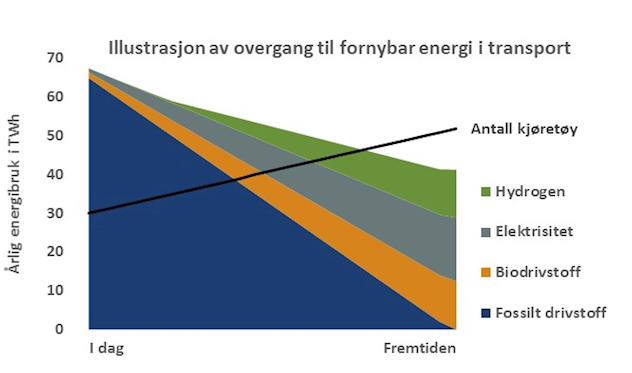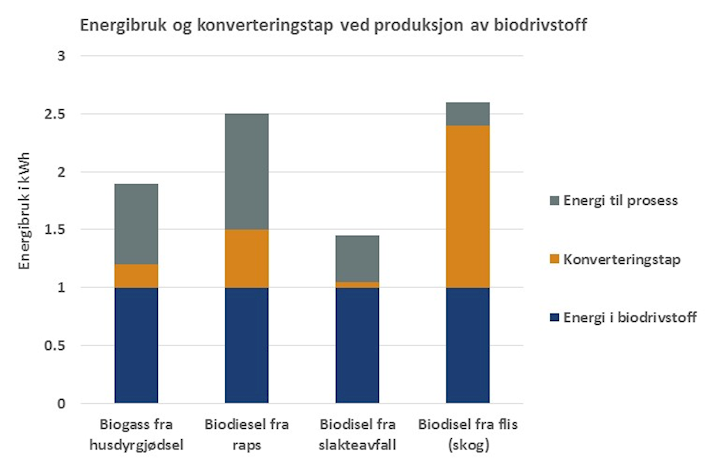In 2014, total energy consumption for transport, machinery and equipment in Norway amounted to 68 TWh.
Energy for transport in 2014. Source SSB - energy balance.
|
|
Total energi |
Gasoline/ diesel |
Marin1 gas oil |
Jet- paraffin |
LNG |
Electricity |
Bio |
|
|
TWh |
TWh |
TWh |
TWh |
TWh |
TWh |
TWh |
|
Road transport |
42,3 |
40,5 |
|
|
0,2 |
0,1 |
1,5 |
|
Coastal transport2 |
13,0 |
0,5 |
11,3 |
|
1,2 |
|
|
|
Aviation |
4,8 |
|
|
4,8 |
|
|
|
|
Rail transport |
0,9 |
0,2 |
|
|
|
0,7 |
|
|
Machinery/tool |
Approx. 7 |
7 |
|
|
|
|
|
|
Sum Transport |
68 |
48,2 |
11,3 |
4,8 |
1,4 |
0,8 |
1,5 |
Today's fossil fuels can be replaced by electricity, hydrogen and biofuels. Since there is still only a small proportion of new vehicles that are fossil-free and many of the vehicles have a life time of 15 to 20 years, it will take a long time before the entire transport and the Norwegian machinery have been replaced with environmentally friendly alternatives. NVE has made assessments of the types of vehicles and machines that can use the electric battery motor and which vehicles can switch to biofuel and hydrogen once after 2030.
Based on today's technology, most passenger cars and vans can use an electric battery motor. The same applies to most buses. Trucks that are not too heavy and should not go too far can also use the electric battery motor. Ferries, passenger ships and many types of machinery and equipment can also use electric battery motors. Range is a problem for some vehicles today, but increasingly new and better vehicles will reduce this problem. Train, subway and tram will probably still have electrical operation in the future.
In particular, vehicles which are very heavy and/or going far might have trouble using an electric battery motor. This applies to everything from heavy, long distance transport on highways, to large ships and aircraft. For these way of transport, today's battery technology will complicate efficient transport and there may also be security aspects of using an electric battery motor in airplanes. For these means of transport, biofuels and hydrogen can be a good alternative to today's fossil fuels.
Overview of possible electric battery operation in various modes of transport. Source NVE.
|
|
Approx. Electric battery by fossil free transport |
Other energy products by fossil free transport |
|
Vehicles |
TWh |
TWh |
|
Passenger cars |
7 - 8 |
|
|
Vans |
Approx. 2,5 |
|
|
Buses |
Approx. 1 |
|
|
Trucks |
Approx. 1 |
|
|
Long distance transport/trailers |
|
6 - 7 |
|
Train, subway, tram (electrical operation) |
Approx. 1 |
|
|
Ferries, ports, passenger ships |
Approx. 1 |
|
|
Ships and Fishing boats |
|
Approx. 10 |
|
Machinery and tool |
Approx. 1 |
Approx. 4 |
|
Domestic air flights |
|
Approx. 5 |
|
Total (i) |
Approx. 15 |
Approx. 25 |
(i) The figures are rough estimates and cannot be seen as a projection of energy consumption for transport.
Since the electric battery motor is three to four times as effective as the current combustion engine, transition to electric battery operation will reduce overall energy consumption for transport, although the number of vehicles will increase in the future. This is illustrated in the figure below.

Hydrogen
Hydrogen can be produced in various ways, such as steam reforming of natural gas and electrolysis of water. Electrolysis uses electricity to cleave water molecules in hydrogen and oxygen. The hydrogen must then be cooled down and compressed before the fuel tank can be filled in a vehicle. It is common to assume that 40 to 45 percent of the energy content of the supplied electricity is lost in production, cooling and compression of hydrogen. Larger plants will have higher efficiency than small plants. There will also be some energy for possible transport of hydrogen to the consumer. One can therefore roughly expect that 2 kWh of electricity will produce hydrogen with an energy content of 1 kWh. This is significantly higher than the use of electricity directly in an electric battery motor, which accounts for 10 percent loss in the transmission grid and 10 percent loss while charging the battery. The fuel cell has an efficiency of 60 to 70 percent, which is also lower than for baelectric vehicles. However, hydrogen-electric vehicles are more than twice as efficient as gasoline and diesel engines, which have an efficiency of around 25 percent.
Summarised, the use of hydrogen for transport is about half as energy efficient as electric battery from production to end-use, but more energy efficient than today's gasoline and diesel cars. The reason why hydrogen can still play a role in future transport and power systems is that hydrogen-electric vehicles have long reach and that hydrogen can be produced and stored when the electricity in an area has few alternative applications. This means that hydrogen can be a good alternative for vehicles that are going to drive far and that it can act as a warehouse for excess power. Moreover, hydrogen vehicles do not charge the power grid with battery charging. Hydrogen production can therefore be a new large consumer group of electricity in Norway. Hydrogen company NEL is investigating the possibilities for large-scale hydrogen production in Norway.
Biofuel
Biofuels can be both bioethanol and biodiesel and are manufactured from a variety of energy products. Both offal, rapeseed, wood and several other biological materials can be used to produce biofuels. There are major differences in energy consumption in the various production modes. The most energy efficient is to produce biofuels from agricultural products, cooking oil and waste waste. However, this kind of production has challenges in terms of sustainability and access to raw materials. Therefore, the biofuels of the future will probably largely be produced from forestry. In the production of biodiesel from forest wood, less than half of the energy content of the forestry remains in the biodiesel sector. Therefore, large amounts of timber will be required to produce the amount of fuel required to meet today's fuel demand for transportation. In addition, energy is needed to drive the processes of production of biofuels. These can be combinations of surplus heat from the process and electricity. Energy consumption and conversion losses in the production of various types of biofuels are shown in the figure below.
The advantage of biofuels is that it can be used in today's internal combustion engines and as a mixture of gasoline and diesel. This makes it easy to reduce the use of fossil fuels. Several transport companies, such as Ruter and Avinor, use a lot of biofuels for buses and aircraft, respectively. Biofuels can be an alternative to way of transports for for those todau with difficulties in using electric battery operation.

